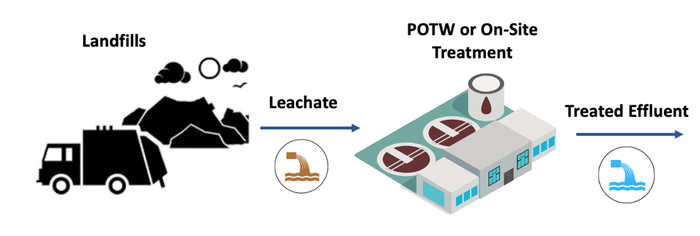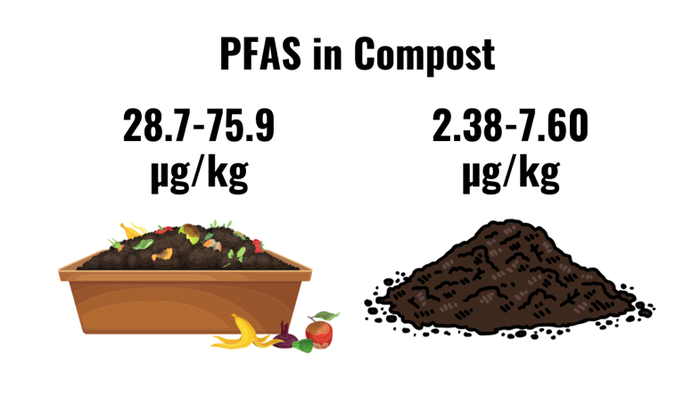A Spotlight on PFAS Solid Waste Research in 2021: What Did We Know?
January 25, 2022

The solid waste industry continued to see lots of changes in the discussion around per- and polyfluoroalkyl substances (PFAS) that were driven by the need to advance science to fully understand how to manage these compounds as well as the impacts of pending regulatory efforts by federal, state, and local agencies. The scientific community continues to make significant strides to tackle the need for more research to address the challenge of understanding and managing PFAS. When discussing the intersection of PFAS management and the solid waste industry, it is a complex challenge for those involved since PFAS is so intertwined in our daily lives that is it is a significant challenge to track and comprehensively understand where PFAS is in solid waste. Despite these challenges, regulators, industry, and researchers continue to push forward and generate new and transformative data.
Since PFAS became a focus of regulators and the public there have been a plethora of reports and publications that have come out that addressed multiple areas that affect the solid waste industry.
PFAS in Solid Waste
Since our industry focuses on the collection and management of a wide range of wastes, the mass flow of PFAS is an important piece of information that is needed to fully understand what PFAS is entering the waste management system, where is it going, and how to best manage associated gaseous and liquid emissions. To date, it is well understood that PFAS is found in a wide variety of industrial and consumer products and most notably the concentrations and types of PFAS present vary widely. The focus in the literature and other studies have been more on industrial and special wastes, cosmetics, food packaging, carpets, and textiles.

There are still studies needed to cover a wider range of consumer items that are broadly used across the country. The use of trade secrets has made it even more challenging to fully inventory PFAS-containing products and wastes. The U.S. EPA has proposed a rule to require all manufacturers (including importers) of PFAS in any year since 2011 to give the U.S. EPA a wide range of data that will include how certain PFAS have been used. This information will be helpful as a step towards closing the loop in determining an approximate mass balance of PFAS entering the solid waste management system.
Landfills
A majority of the research that has been conducted to date on PFAS has focused on the detection and quantification of PFAS in landfill leachate and effective treatment approaches. Therefore, it is known that once PFAS enters a landfill the anaerobic environment promotes the conversion of longer-chain compounds to shorter-chain. In addition, due to the shift from longer-chain compounds to shorter in manufacturing and consumer products in the U.S., there is a prevalence of shorter-chain compounds in landfill leachate. This information is important to determine the appropriate treatment approaches.
In the U.S., leachate is predominately discharged to wastewater treatment plants (WWTPs) for treatment. Limited statewide studies and peer-reviewed literature have suggested that leachate provides a relatively minor contribution to the overall perfluorooctanoic acid (PFOA) and perfluorooctane sulfonic acid (PFOS) concentration in most influents (Hart & Hickman, 2020; Masoner et al., 2020; NTH, 2019).

The EPA’s Preliminary Effluent Guidelines Program Plan 15 (Preliminary Plan 15) specifically highlights the focus on landfill leachate contribution to PFAS present in WWTPs and expanding the focus beyond PFOA and PFOS. On-site leachate treatment options that are currently proven and have been shown to remove over 90% of PFAS includes adsorption and filtrations technologies as discussed in PFAS Leachate Treatment Breaking Down the Bond Barrier – Part 1: Treatment Basics. Although these technologies are effective at removing PFAS from leachate, PFAS-containing residuals will be generated and require additional management. Currently, the potential options for disposal include landfilling, incineration, and solidification/stabilization. The latter is still in its infancy but shows promise as a way to immobilize PFAS. Efforts to understand ways to destruct PFAS in leachate as opposed to concentrating are emerging and currently being evaluated at bench-scale by many researchers as highlighted in PFAS Leachate Treatment Breaking Down the Bond Barrier – Part 2: Breaking the Bond Barrier by Advancing Current Treatment Technologies.
Landfill liners have been shown to be effective at controlling PFAS emissions and a study published in 2020, has shown that linear low-density polyethylene (LLDPE) and LLDPE coextruded with ethylene vinyl alcohol are effective at limiting the diffusion of PFAS (Di Battista et al., 2020). A study being funded by the Environmental Research & Education Foundation is currently evaluating conventional Subtitle D liners to understand the diffusion of PFAS.�
The presence of PFAS in landfill gas has been broadly unknown due to the lack of an appropriate and reliable method to capture and then characterize PFAS. The U.S. EPA funded an on-going study at North Carolina State University to develop a suitable method to study PFAS in landfill gas. Preliminary studies have demonstrated that fluorotelomer alcohols (FtOH) are present. FtOH is known to be volatile which means it is more likely to move from liquid to gas phase These observations provide evidence that PFAS can become mobile in landfill gas.
Compost
Studies by Choi et al. (2019) and Thakali and MacRae (2021) have demonstrated that compost can contain PFAS but at varying concentrations depending on feedstock source. Choi et al. (2019) showed that the organic fraction of MSW with food packaging (28.7-75.9 µg/kg) had significantly higher concentration of PFAS relative to the organic fraction without food packaging (2.38-7.60 µg/kg).

Similar to landfills, the PFAS detected in these samples were dominated by shorter chain compounds. Thakali and MacRae (2021) supported the contribution of food waste to PFAS being detected in compost since they also found PFAS in food waste samples. There are still knowledge gaps in expanding the sampling and characterization of other sources of compost as well as determining why samples without food packaging contain PFAS.
Thermal Treatment
Thermal conversion and destruction are identified as preferred management approaches in the U.S. EPA’s Interim Guidance on the Destruction and Disposal of Perfluoroalkyl and Polyfluoroalkyl Substances and Materials Containing Perfluoroalkyl and Polyfluoroalkyl Substances. Outlined in this guidance is the limited research on the complete combustion of PFAS via waste-to-energy (WTE). There is evidence that the destruction of fluorotelomer-based polymers is possible at temperatures greater than 1,000°C and 2s residence time. Research is needed to understand the efficacy of WTE processes to fully destruct PFAS in addition to a methodology to characterize PFAS emissions. If the incoming PFAS is not fully destructed and is still present as a longer or shorter compound, then products of incomplete combustion are formed. Currently, it is not clear if products of incomplete combustion would be produced and under what conditions (i.e., time, temperature, and turbulence). The presence of PFAS in fly and bottom ash has been demonstrated in a few studies that provide some evidence of PFAS being retained in the ash (Liu et al., 2021; Solo-Gabriele et al., 2020). A study recently funded by the Environmental Research & Education Foundation, will address these knowledge gaps to understand the efficacy of solid waste combustion to destruct PFAS-containing wastes.
The existing research has proven to provide value information to be proactive about managing PFAS wastes and make sound science-based decisions. The research published in 2021 has provided new and timely information that builds upon previous research and is highlighted in next article on “A Spotlight on PFAS Solid Waste Research in 2021: What Have We Learned?”.
References
Choi, Y.J., Kim Lazcano, R., Yousefi, P., Trim, H., Lee, L.S. 2019. Perfluoroalkyl Acid Characterization in U.S. Municipal Organic Solid Waste Composts. Environmental Science & Technology Letters, 6(6), 372-377.
Di Battista, V., Rowe, R.K., Patch, D., Weber, K. 2020. PFOA and PFOS diffusion through LLDPE and LLDPE coextruded with EVOH at 22 °C, 35 °C, and 50 °C. Waste Management, 117, 93-103.
Hart & Hickman. 2020. Collective Study of PFAS and 1,4-Dioxane in Landfill Leachate and Estimated Influence on Wastewater Treatment Plant Facility Influent
Liu, S., Zhao, S., Liang, Z., Wang, F., Sun, F., Chen, D. 2021. Perfluoroalkyl substances (PFASs) in leachate, fly ash, and bottom ash from waste incineration plants: Implications for the environmental release of PFAS. Science of The Total Environment, 795, 148468.
Masoner, J.R., Kolpin, D.W., Cozzarelli, I.M., Smalling, K.L., Bolyard, S.C., Field, J.A., Furlong, E.T., Gray, J.L., Lozinski, D., Reinhart, D., Rodowa, A., Bradley, P.M. 2020. Landfill leachate contributes per-/poly-fluoroalkyl substances (PFAS) and pharmaceuticals to municipal wastewater. Environmental Science: Water Research & Technology, 6(5), 1300-1311.
NTH. 2019. Michigan Waste & Recycling Association Statewide Study on Landfi ll Leachate PFOA and PFOS Impact on Water Resource Recovery Facility Infl uent
Solo-Gabriele, H.M., Jones, A.S., Lindstrom, A.B., Lang, J.R. 2020. Waste type, incineration, and aeration are associated with per- and polyfluoroalkyl levels in landfill leachates. Waste Management, 107, 191-200.
Thakali, A., MacRae, J.D. 2021. A review of chemical and microbial contamination in food: What are the threats to a circular food system? Environmental Research, 194, 110635.
About the Author
You May Also Like


.png?width=300&auto=webp&quality=80&disable=upscale)